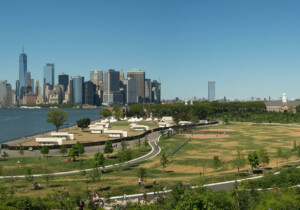Since its founding in 1996, SHoP Architects has been committed to fostering architectural innovation despite on-the-ground constraints. In New York, those constraints often take the form of municipal regulations. “From day one SHoP was always a firm that was interested in pushing the limits of design, really getting into materials and craftsmanship,” said principal Gregg Pasquarelli. “But we were also building in the pressure tank of New York, where a lot of the innovation has to occur in the skins of the buildings, because zoning is so prescriptive.” Pasquarelli will outline his firm’s approach to cutting-edge facade design in the context of New York’s regulatory environment in the afternoon keynote address at next month’s Facades+ NYC conference.
For SHoP, “innovation” extends not just to the materials and systems the firm uses, but to the way the architects with other members of the AEC industry. “We learned that to build innovative facades, we had to interact with the construction industry in a new way,” he said. In 2003, for a 20,000-square-foot addition to the historic Porter House warehouse, the designers collaborated with the fabricator to digitally design a custom zinc skin. “It was 2002 and it was the first facade completely designed and manufactured using 100 percent digital fabrication,” said Pasquarelli. “We were way out in front of everyone, but it was our joint venture with the developer and the contractor that allowed innovation.” SHoP has carried a similar strategy through to more recent projects, including the 2012 Barclays Center, which Pasquarelli describes as “ the only way to get that facade built was to create a joint venture with the contractor in order to fabricate the 12,000 panels of weathered steel for the facade.”
SHoP is known for, among other things, its creative use of a varied material palette. The paired towers of 626 First Avenue, currently under construction, are clad in copper; the recently-unveiled 111 West 57th Street high-rise features a terra cotta and bronze envelope. The diversity, said Pasquarelli, “is more about experimentation than anything else. The thing we don’t like is working with finished materials. We are interested in raw materials, how they patina and age over time.” But while many of SHoP’s designs draw inspiration from the colors and textures of Manhattan’s historic built environment, the architects never lose sight of their ultimate goal: moving building design forward. “What are the limits of these materials now that we’re using CNC equipment to digitally fabricate facades?” asks Pasquarelli. “How can we rethink how traditional materials are used in a very twenty-first-century way?”
For more information or to register for Facades+ NYC, visit the conference website.










